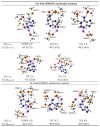Coordination Sites for Sodium and Potassium Ions in Nucleophilic Adeninate Contact ion-Pairs: A Molecular-Wide and Electron Density-Based (MOWED) Perspective
- PMID: 36144844
- PMCID: PMC9505275
- DOI: 10.3390/molecules27186111
Coordination Sites for Sodium and Potassium Ions in Nucleophilic Adeninate Contact ion-Pairs: A Molecular-Wide and Electron Density-Based (MOWED) Perspective
Abstract
The adeninate anion (Ade-) is a useful nucleophile used in the synthesis of many prodrugs (including those for HIV AIDS treatment). It exists as a contact ion-pair (CIP) with Na+ and K+ (M+) but the site of coordination is not obvious from spectroscopic data. Herein, a molecular-wide and electron density-based (MOWED) computational approach implemented in the implicit solvation model showed a strong preference for bidentate ion coordination at the N3 and N9 atoms. The N3N9-CIP has (i) the strongest inter-ionic interaction, by -30 kcal mol-1, with a significant (10-15%) covalent contribution, (ii) the most stabilized bonding framework for Ade-, and (iii) displays the largest ion-induced polarization of Ade-, rendering the N3 and N9 the most negative and, hence, most nucleophilic atoms. Alkylation of the adeninate anion at these two positions can therefore be readily explained when the metal coordinated complex is considered as the nucleophile. The addition of explicit DMSO solvent molecules did not change the trend in most nucleophilic N-atoms of Ade- for the in-plane M-Ade complexes in M-Ade-(DMSO)4 molecular systems. MOWED-based studies of the strength and nature of interactions between DMSO solvent molecules and counter ions and Ade- revealed an interesting and unexpected chemistry of intermolecular chemical bonding.
Keywords: DMSO; REP-FAMSEC; adeninate anion; alkali metals; computational chemistry; coordination modes; ion-pairs; molecular-wide and electron density-based (MOWED) approach; nucleobases.
Conflict of interest statement
The authors declare no conflict of interest. The funders had no role in the design of the study; in the collection, analyses, or interpretation of data; in the writing of the manuscript; or in the decision to publish the results.
Figures



Similar articles
-
Towards a Molecular Understanding of Cation-Anion Interactions and Self-aggregation of Adeninate Salts in DMSO by NMR and UV Spectroscopy and Crystallography.Chemphyschem. 2021 Oct 5;22(19):2025-2033. doi: 10.1002/cphc.202100098. Epub 2021 Aug 8. Chemphyschem. 2021. PMID: 34153151 Free PMC article.
-
Cobalt(III) complexes of monodentate N9-bound adeninate (ade-), [Co(ade-kappaN9)Cl(en)2]+ (en = 1,2-diaminoethane): syntheses, crystal structures, and protonation behaviors of the geometrical isomers.Inorg Chem. 2004 Oct 4;43(20):6435-44. doi: 10.1021/ic035336z. Inorg Chem. 2004. PMID: 15446895
-
Probing the selective separation of potassium ion from sodium ion with cyclopentadienyl anion as receptor: a computational study.J Mol Model. 2015 Aug;21(8):218. doi: 10.1007/s00894-015-2767-1. Epub 2015 Aug 1. J Mol Model. 2015. PMID: 26232185
-
Coordination Chemistry of Nucleotides and Antivirally Active Acyclic Nucleoside Phosphonates, including Mechanistic Considerations.Molecules. 2022 Apr 19;27(9):2625. doi: 10.3390/molecules27092625. Molecules. 2022. PMID: 35565975 Free PMC article. Review.
-
Harnessing Ionic Interactions and Hydrogen Bonding for Nucleophilic Fluorination.Molecules. 2020 Feb 7;25(3):721. doi: 10.3390/molecules25030721. Molecules. 2020. PMID: 32046021 Free PMC article. Review.
Cited by
-
Reaction Kinetics of the Benzylation of Adenine in DMSO: Regio-Selectivity Guided by Entropy.Chemphyschem. 2024 Dec 2;25(23):e202400561. doi: 10.1002/cphc.202400561. Epub 2024 Nov 5. Chemphyschem. 2024. PMID: 39136932 Free PMC article.
References
-
- Ts’o P.O.P. Bases, Nucleosides, and Nucleotides. In: Ts’o P.O.P., editor. Basic Principles in Nucleic Acid Chemistry. Volume 1. Academic Press; New York, NY, USA: 1974. pp. 453–584.
-
- Riley D.L., Walwyn D.R., Edlin C.D. An improved process for the preparation of tenofovir disoproxil fumarate. Org. Process Res. Dev. 2016;20:742–750. doi: 10.1021/acs.oprd.5b00364. - DOI
-
- Arimilli M.N., Cundy K.C., Dougherty J.P., Kim C.U., Oliyai R., Stella V.J. Antiviral phosphonomethoxy nucleotide analogs having increased oral bioavailability. 6,043,230. U.S. Patent. 1999 May 19;
MeSH terms
Substances
Grants and funding
LinkOut - more resources
Full Text Sources

